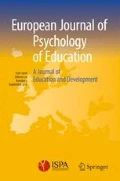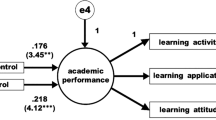Abstract
In order to identify differences in determinants of supportive and class use of computers, path modelling was applied in a sample of 468 primary school teachers. Independent variables were categorised in three levels: demographics (age and gender), computer experience (computer training, computer experience expressed over time, intensity of computer use), and attitude measures (general computer attitudes, attitudes toward computers in education, and technological innovativeness).
Supportive and class use of computers are not related to the same set of variables. Supportive computer use was mainly predicted by computer experience variables and general computer attitudes. Strongest predictors of class use were technological innovativeness and gender. Yet, the degree of explained variance for class use of computer was considerably lower compared to supportive computer use. These results indicate the limitations of explaining complex forms of professional computer use on the basis of both individual determinants and quantitative models. The article concludes with some practical implications and recommendations for further research.
Résumé
A fin d’identifier les différences dans les déterminants de l’utilisation de l’ordinateur comme support et en classe, path modelling a été appliqué au moyen d’un échantillon de 468 instituteurs.
Les variables indépendantes ont été catégorisées en trois niveaux: démographie (âge et sexe), expérience avec l’ordinateur (apprentissage d’informatique, expérience informatique exprimée en fonction du temps et de l’intensité de l’utilisation de l’ordinateur), et mesures d’attitude (attitudes générales vis-à-vis de l’ordinateur, attitudes vis-à-vis de l’emploi d’ordinateurs dans l’enseignement et de l’innovation technologique).
L’utilisation de l’ordinateur comme support et celle en classe ne sont pas relatées au même ensemble de variables. L’emploi comme support est principalement prédit par les variables qui expriment l’expérience avec l’ordinateur et les attitudes générales vis-à-vis de l’ordinateur. Les prédicateurs les plus forts pour l’emploi en classe sont l’attitude par rapport à l’innovation technologique et le sexe. Mais le degré de la variance expliquée est considérablement plus faible pour ce qui concerne l’utilisation en classe que pour l’utilisation comme support. Ces résultats indiquent les limitations à expliquer des formes complexes de l’utilisation professionnelle de l’ordinateur à base de déterminants individuels et de models quantitatifs. L’article conclue avec quelques implications pratiques et recommandations pour des recherches futures.
Similar content being viewed by others
References
Al Khaldi, M.A., & Al Jabri, I.M. (1998). The relationship of attitudes to computer utilization: New evidence from a developing nation.Computers in Human Behavior, 14(1), 23–42.
Arbuckle, J.L. (2003).Amos 5.0 Update to the Amos User’s Guide. Chicago, IL: Smallwaters Corporation.
Arbuckle, J.L., & Wothke, W. (1999).Amos 4.0 User’s Guide. Chicago, IL: Smallwaters Corporation.
Baylor, A.L., & Ritchie, D. (2002). What factors facilitate teacher skill, teacher morale, and perceived student learning in technology-using classrooms?Computers & Education, 39(4), 395–414.
Becta (n.d.).ICT advice for teachers. Retrieved January 8, 2004, from
Bradley, G., & Russell, G. (1997). Computer experience, school support, and computer anxiety.Educational Psychology: An International Journal of Experimental Educational Psychology, 17(3), 267–284.
Charlton, J.P., & Birkett, P.E. (1995). The development and validation of the Computer Apathy and Anxiety Scale.Journal of Educational Computing Research, 13(1), 41–59.
Chiero, R.T. (1997). Teachers’ perpectives on factors that affect computer use.Journal of Research on Computing in Education, 30(2), 133–145.
Cox, M., Abbott, C., Webb, M., Blakeley, B., Beauchamp, T., & Rhodes, V. (2004).ICT and Pedagogy — A review of the literature.ICT in Schools Research and Evaluation Series, 18. London: DfES/BECTA.
Cuban, L., Kirkpatrick, H., & Peck, C. (2001). High access and low use of technologies in high school classrooms: Explaining an apparent paradox.American Educational Research Journal, 38(4), 813–834.
DeYoung, C.G., & Spence, I. (2004). Profiling information technology users: En route to dynamic personalization.Computers in Human Behavior, 20(1), 55–65.
Eiser, J.R., & van der. Pligt, J. (1988).Attitudes and Decisions. London: Routledge.
Francis, L.J., & Evans, T.E. (1995). The reliability and validity of the Bath County Computer Attitude Scale.Journal of Educational Computing Research, 12(2), 135–146.
Furst-Bowe, J., Boger, C., Franklin, T., McIntyre, B., Polansky, J., & Schlough, S. (1995). An analysis of required computer competencies for university students.Journal of Research on Computing in Education, 28(2), 175–189.
Galanouli, D., Murphy, C., & Gardner, J. (2004). Teachers’ perceptions of the effectiveness of ICT-competence training.Computers & Education, 43(1–2), 63–79.
Hogarty, K.Y., Lang, T.R., & Kromrey, J.D. (2003). Another look at technology use in classrooms: The development and validation of an instrument to measure teachers’ perceptions.Educational and Psychological Measurement, 63(1), 139–162.
Jenson, J., & Rose, C.B. (2003). Women@work: Listening to gendered relations of power in teacher’ talk about new technologies.Gender & Education, 15(2), 169–181.
Jenson, J., De Castell, S., & Bryson, M. (2003). “Girl talk”: Gender, equity, and identity discourses in a school-based computer culture.Women’s Studies International Forum, 26(6), 561–574.
Kadijevich, D. (2000). Gender differences in computer attitude among ninth-grade students.Journal of Educational Computing Research, 22(2) 145–154.
Kay, R. (1989). A practical and theoretical approach to assessing computer attitudes: The Computer attitude Measure (CAM).Journal of Research on Computing in Education, 21(4), 456–463.
Kay, R. (1992). Understanding gender differences in computer attitudes: Aptitude, and use: An invitation to build theory.Journal of Research on Computing in Education, 25(2), 159–171.
Kennewell, S., Parkinson, J., & Tanner, H. (2000).Developing the ICT Capable School. London: RouteledgeFalmer.
Khine, S.M. (2001). Attitudes toward computers among teacher education students in Brunei Darussalam.International Journal of Instructional Media, 28(2), 147–152.
Kreft, I., & De Leeuw, J. (1998). Introducing multilevel modeling. London. Sage.
Levine, T., & Donitsa-Schmidt, S. (1998). Computer use, confidence, attitudes, and knowledge: a causal analysis.Computers in Human Behavior, 14(1), 125–146.
Looker, E.D., & Thiessen, V. (2003). Beyond the digital divide in Canadian schools. From access to competency in the use of information technology.Social Science Computer Review, 21(4), 475–490.
Loveless, A., & Dore, B. (Eds.). (2002).ICT in the primary school. Learning and Teaching with ICT. Buckingham: Open University Press.
Loyd, B.H., & Gressard, C. (1984). Reliability and factorial validity of computer attitude scales.Educational and Psychological Measurement, 44(2), 501–505.
Loyd, B.H., & Loyd, D.E. (1985). The reliability and validity of an instrument for the assessment of computer attitudes.Educational and Psychological Measurement, 45(4), 903–908.
Maier, P., Barnett, L., Warren, A., & Brunner, D. (1999).Using Technology in Teaching and Education. London: Kogan Page.
Marcinkiewicz, H.R. (1993). Computers and teachers: Factors influencing computer use in the classroom.Journal of Research on Computing in Education, 26(2), 220–237.
Marcoulides, G.A., & Schumacker, R.E. (2001) New Developments and Techniques in Structural Equation Modeling. Mahwah, NJ: Erlbaum.
Mathews, J.G., & Guarino, A.J. (2000). Predicting teacher computer use: A path analyses.International Journal of Instructional Media, 27(4), 385–392.
Mitra, A. (2001). Developing a questionnaire to measure the effectiveness of computers in teaching.Proceedings of the Annual ED-MEDIA — World Conference on Educational Multimedia, Hypermedia and Telecommunications (pp. 1327–1328). AACE. Tampere, Finland.
Potosky, D., & Bobko, Ph. (2001). A model for predicting computer experience from attitudes toward computers.Journal of Business and Psychology, 15(3), 391–404.
Robertson, J. (2002). The ambiguous embrace: Twenty years of IT (ICT) in UK primary schools.British Journal of Educational Technology, 33(4), 403–409.
Roehrich, G. (2004). Consumer innovativeness. Concepts and measurements.Journal of Business Research, 57(6), 671–677.
Rogers, E.M. (1995).Diffusion of Innovations, Fourth Edition. New York: Free Press.
Rogers, E.M., & Shoemaker, F.F. (1971).Communication of Innovations: A Cross-Cultural approach. New York: Free Press.
Rozell, E.J., & Gardner, W.L. (1999). Computer-related success and failure: A longitudinal field study of the factors influencing computer-related performance.Computers in Human Behavior, 15(1), 1–10.
Shapka, J.D., & Ferrari, M. (2003). Computer-related attitudes and actions of teacher candidates.Computers in Human Behavior, 19(3), 319–334.
Shashaani, L. (1997). Gender differences in computer attitudes and use among college students.Journal of Educational Computing Research, 16(1), 37–51.
Tan, S.C., Hu, C., Wong, S.K., & Wettasinghe, C.M. (2003). Teacher training on technology-enhanced instruction — A holistic approach.Educational Technology & Society 6(1), 96–104.
Tearle, P. (2003). ICT implementation: What makes the difference?British Journal of Educational Technology, 34 (5), 403–417.
Tuijnman, A.C., & Ten Brummelhuis, A.C.A. (1992). Determinants of computer use in lower secondary schools in Japan and the United States.Computers & Education, 19(3), 291–300.
van Braak, J., & Goeman, K. (2003). Differences between general computer attitudes and perceived computer attributes: Development and validation of a scale.Psychological Reports, 92, 655–660.
van Braak, J. (2001). Individual characteristics influencing teachers’ class use of computers.Journal of Educational Computing Research, 25(2), 141–157.
van Braak, J. (2004). Domains and determinants of university students’ self-perceived computer competence.Computers and Education, 43(3), 299–312.
Volman, M., & van Eck, E. (2001). Gender equity and information technology in education: The second decade.Review of Educational Research, 71(4), 613–634.
Williams, D., Coles, L., Wilson, K., Richardson, A., & Tuson, J. (2000). Teachers and ICT: Current use and future needs.British Journal of Educational Technology, 31(4), 307–320.
Winter, S.J., Chudoba, K.M., & Gutek, B.A. (1998). Attitudes toward computers — When do they predict computer use?Information and Management, 34(5), 275–284.
Author information
Authors and Affiliations
Rights and permissions
About this article
Cite this article
van Braak, J., Tondeur, J. & Valcke, M. Explaining different types of computer use among primary school teachers. Eur J Psychol Educ 19, 407–422 (2004). https://doi.org/10.1007/BF03173218
Received:
Revised:
Issue Date:
DOI: https://doi.org/10.1007/BF03173218




